Electronic data interchange (EDI) is a staple in the business world, providing a quick and secure method for document transfer. Of all electronic business transactions, those facilitated by EDI processes total over 20 billion transactions per year. Over 60% of businesses across the United States already use EDI in their daily operations, benefitting from the cost savings, speed and accuracy of EDI. But what is EDI, and what are the advantages of EDI that make it so attractive to businesses? You’ll find your answers here.
- What Is Electronic Data Interchange?
- Purpose and Function of EDI
- Key Benefits and Advantages of EDI in E-Commerce
- Infrastructure for EDI
- Examples of EDI
- How EDI Integration Works
- How Can I Add EDI to My Business?
- EDI Business Process Review
- Implement EDI With Finale Inventory
What Is Electronic Data Interchange?
EDI is a significant subset of electronic commerce, which is the use of technology to facilitate an exchange of information between two parties. Most electronic commerce intends to automate certain business processes and make them as paperless as possible. However, most electronic commerce requires some level of manual intervention, such as the input of data into a computer system or the scanning of paper documents. EDI differentiates itself from other forms of electronic commerce by being completely automated from start to finish.
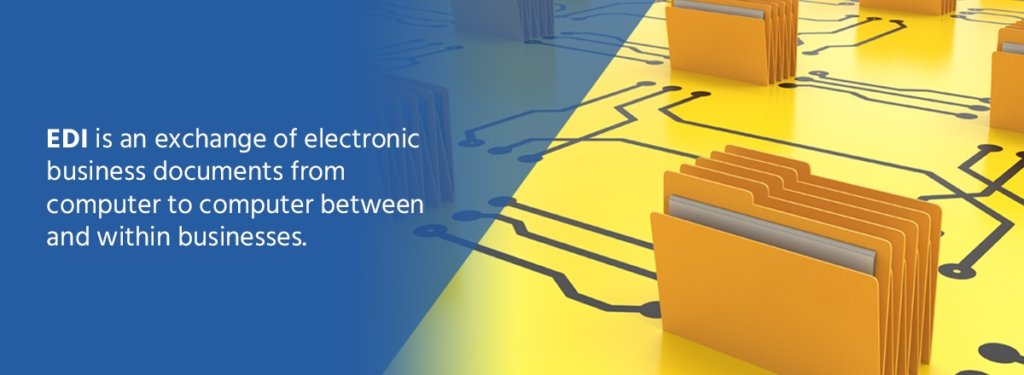

Purpose and Function of EDI
At its most basic, EDI is an exchange of electronic business documents from computer to computer between and within businesses. EDI contains critical transactional information and is structured in a standardized format to allow for easy and automated retrieval. For example, a retailer and a manufacturer exchange EDI when a retailer submits a digital purchase order for a product, the manufacturer sends a digital invoice, and both parties send electronic receipts. The core purpose of EDI is to transfer data automatically and securely — a purpose that offers many benefits to businesses of all types.
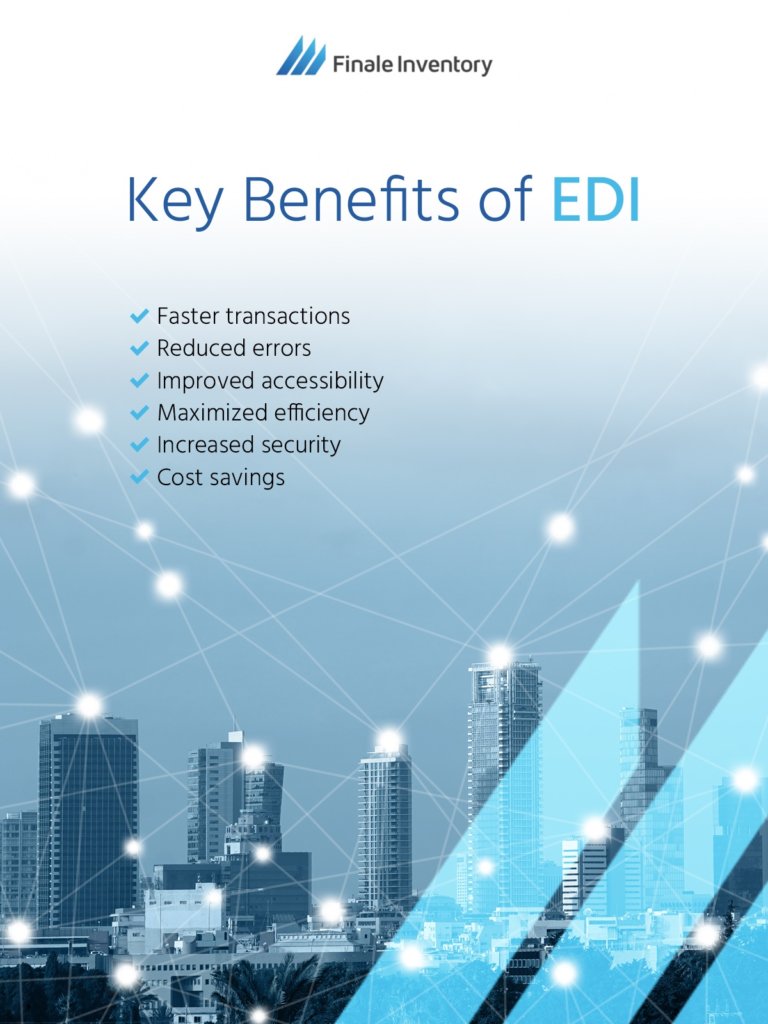

Key Benefits and Advantages of EDI in E-Commerce
EDI was originally developed to solve the multitude of problems inherent in manual communications. By facilitating automation and a smoother flow of information, EDI offers many benefits to companies. These benefits are why so many companies still choose to use EDI in their operations. Some of the advantages of EDI include:
- Faster transactions: Paper documents take time to transport from location to location, while manually-entered electronic forms take time to fill, file and retrieve. EDI enables companies to eliminate these time-consuming tasks, cutting processing time through automation. For example, EDI can help reduce order-to-shipment cycles, allowing faster turnaround times and greater customer satisfaction.
- Reduced errors: Non-EDI systems involve manual processes that are naturally more error-prone than a computer. EDI eliminates this with automated entry and data processing, removing the possibility of human error.
- Improved accessibility: Non-EDI systems are more difficult to access quickly due to the inherent time delays and manual processes needed to process data. EDI is more immediate and automated, allowing the user access to a range of transactional data. This enables businesses to manage accounts and inventory more accurately.
- Maximized efficiency: With faster speeds, reduced errors and better accessibility, EDI offers improved efficiency across the board for corporations. By eliminating time-consuming manual processes and data processing tasks, businesses can allocate their people and resources to tasks that more directly impact customer relationships and add value to the company.
- Increased security: While manual processes may seem secure, the human error involved actually increases security risks, allowing room for inaccuracies and loss of data. With EDI, processes are automated, and documents are transferred through a secure connection, eliminating costly errors. Additionally, EDI makes it easier to track and store data for auditing purposes, ensuring that your company is ready to meet industry compliance standards.
- Cost savings: All the above-listed benefits result in a system that saves businesses money. While non-EDI systems incur labor and materials costs and allow for costly errors, EDI systems eliminate these problems. Electronic-only documentation reduces material costs, while automation reduces labor costs and expensive errors.
With these EDI benefits, it’s no wonder so many businesses choose to implement it in their business structures.
Infrastructure for EDI
Now that you understand the benefits of EDI, it’s important to understand how EDI works from a structural perspective. For EDI to work, a business must have an infrastructure designed to facilitate it. This infrastructure must include four key elements of electronic data exchange, which are described in more detail below:
1. Format Standards
The most basic need for an EDI system is a standard format in which information is organized. This format defines what data is included, how it is written and where it goes. When EDI was first used in the 1960s, EDI formats were proprietary, designed and used by companies to communicate with their partners. As the technology expanded in use, however, businesses found that there were too many conflicting formats to manage complex trading relationships efficiently. As a result, industry groups developed standard formats.
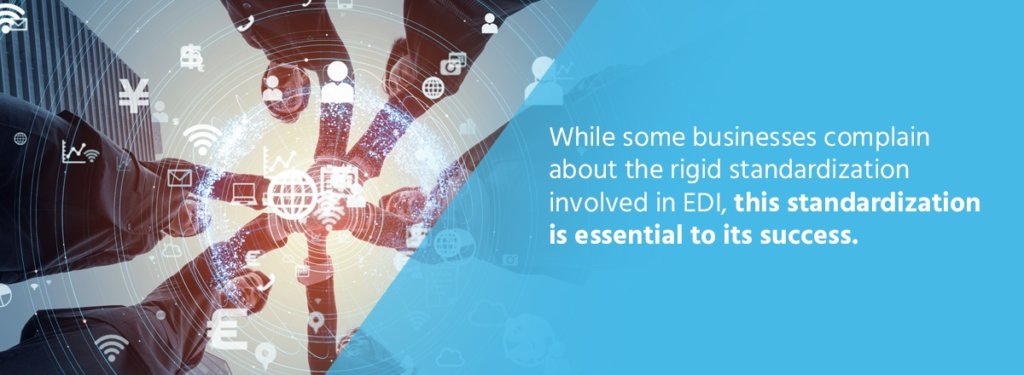

The first EDI format standard was approved by the U.S. Transportation Data Coordinating Committee in 1975, establishing the basis upon which all modern standards are founded. Today, the American National Standards Institute (ANSI) develops and maintains format standards. Its baseline for all industry EDI formats is called ANSI X12. While some businesses complain about the rigid standardization involved in EDI, this standardization is essential to its success, allowing businesses to exchange data efficiently and avoid the problems encountered by early adopters in the 1960s.
Although ANSI X12 serves as a baseline for EDI format standards, industries have established their own standards and conventions, adjusting ANSI X12 to fit the specific needs of their industry. For example, although ANSI X12 defines codes for over 400 units of measure, the automotive industry format only defines those applicable to the industry, making it less confusing for users.
ANSI is also not the only format standard in the world. You may also see the term UN/EDIFACT or simply EDIFACT. This stands for United Nations/Electronic Data Interchange for Administration, Commerce and Transport, which is the standard established by the United Nations and is the most common EDI standard used outside of the United States.
Some other common format standards in use across the world today include:
- HIPAA: The U.S. Health Insurance Portability and Accountability Act of 1996 established national standards for electronic health record transmission. EDI use in the U.S. healthcare system was covered under this act, and HIPAA set format standards based on the X12 format.
- RosettaNet: This format is commonly used in the electronics, telecommunications and logistics industries, which often interact on a global scale.
- Tradacoms: This early EDI format standard was primarily used in the retail sector in the U.K. and grew to be a common format in the global market. Though EDIFACT has now become the global standard, this format is still commonly used in the U.K.
2. Translation Software
Translation software takes data and converts it from internal formats to generic EDI formats and back again. For example, a sending company may use translation software to pull data from their database and translate it into a generic EDI format. The sending company then sends that document to the receiving company. Once they receive the document, the receiving company uses another translation software to translate the generic EDI format to their own internal format.
3. EDI Networks
Companies send EDI from one company to another using various transmission methods. While EDI was historically sent using only the direct EDI method, the advent of the internet and mobile devices have introduced more ways to transfer documents. Some of the common methods used to facilitate EDI are described below:
- Direct EDI: Direct EDI, also known as point-to-point EDI, involves a direct connection between two businesses that have a lot of daily transactions. With this type of EDI, the businesses establish a direct connection where their system facilitates the transactions automatically. This is how companies originally handled EDI documents but poses problems when businesses use different communication protocols and computer hardware systems.
- EDI network services provider: An EDI network services provider, also called a value-added network (VAN), is a common alternative to direct EDI. In these systems, business partners use a secure network provided by a third party. This allows businesses to avoid managing multiple communication protocols from their business partners.
- Web EDI: Web EDI uses a standard browser and online forms to conduct EDI over the internet. This method is highly affordable, allowing small- to medium-sized organizations to benefit from EDI without incurring significant IT costs.
- Mobile EDI: EDI network services providers are increasingly offering mobile options for facilitating EDI. While currently limited due to security concerns over mobile devices, mobile EDI is expected to expand substantially over the next decade.
EDI transfer methods are expected to expand further in the future to meet the various needs of different types of businesses and partnerships.
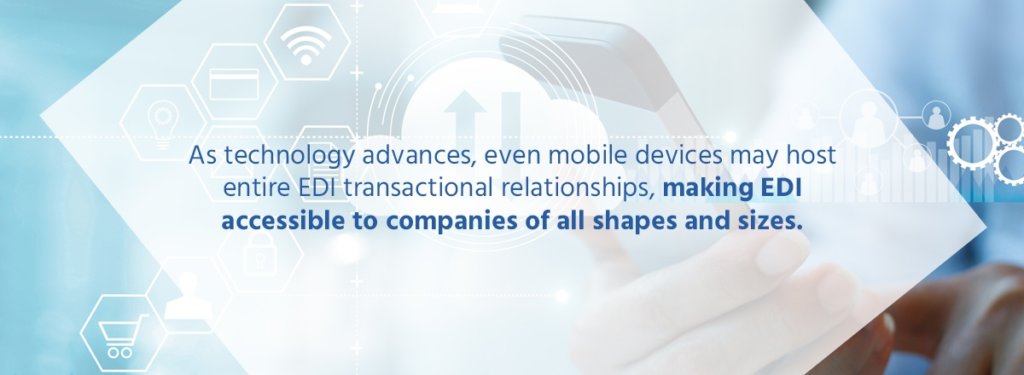

4. Computers
The last thing needed for an EDI infrastructure is a computer. Being a digital format, electronic data interchange applications in business require basic computers to function. While larger companies may facilitate EDI using extensive IT infrastructures, even small businesses with a single machine may use an EDI system. As technology advances, even mobile devices may host entire EDI transactional relationships, making EDI accessible to companies of all shapes and sizes.
Examples of EDI
Many industries already use EDI in their day-to-day operations, benefitting from the various advantages of EDI in eCommerce.
hey have a number of solutions in place for drop shippers and suppliers to receive orders from a number of major marketplaces—Walmart, Costco, and other large retailers via EDI.Some industries and illustrative examples are listed below:
1. Pharmaceutical Industry
The pharmaceutical industry relies on extreme accuracy in everything, and that extends to their business-to-business communications. The sector was one of the early adopters of EDI technology and presents one of the most successful implementations of EDI in the Bergen Brunswig Drug Company. This wholesale pharmaceutical distributor uses EDI in many business processes from top to bottom. Orders are submitted when a pharmacist scans their product inventory. Once scanned, a microcomputer processes the information and generates an electronic order, which the pharmacist reviews and sends to a distribution center. A computer at the center analyzes and resequences the order and sends it to the floor to pull. This electronic process has significantly reduced error and turnaround time for Bergen Brunswig distribution centers, representing a major success for EDI technology.
2. Retail Industry
The retail industry commonly uses EDI in several day-to-day operations. Retailers often use EDI to place supply orders similar to the Bergen Brunswig model. They also manage most invoices using EDI, which the JCPenney Company found helped to significantly reduce their overhead costs by reducing errors, increasing turnaround times and reducing labor costs. They were even able to consolidate processing centers into a single location by switching to an EDI system. Due to the benefits of EDI, many large retailers such as Walmart, Costco, and Home Deport will only send transactions to their suppliers through EDI so having EDI capability is a must for companies wanting to conduct business with the large Fortune 500 retailers.
3. Automotive Industry
The U.S. auto industry is also a strong user of EDI technology. Chrysler, for example, applied EDI to its manufacturing process, improving communication with material suppliers and eliminating the need for invoices. Chrysler did this by creating weekly electronic material releases, forecasting their future material needs for ongoing projects. As workers use parts and the plans change, the forecast updates. A week before the parts are needed, the Chrysler system uses this forecast to send an EDI order for the necessary parts. The supplier then pulls these parts and sends an EDI advanced shipping notice to verify that the delivery is en route. Once they receive the parts, Chrysler scans them in — if there are any discrepancies, the system identifies them and sends a discrepancy report to the supplier. This system allowed Chrysler to improve its inventory and space usage, cutting costs significantly.
4. Financial Industry
The financial industry implements EDI in a wide range of operations, both business-driven and consumer-driven. The two primary types of financial industry EDI transactions are Financial EDI (FEDI) and Electronic Funds Transfer (EFT). FEDI takes place between banks and their customers or between banks when there is no transfer of value. For example, a customer pulling an electronic statement would be a FEDI. EFT, on the other hand, involves the transfer of monetary value from one account at one institution to an account at another institution. Automated Clearing House (ACH) payments are an example of this. Companies often use these types of payments to pay employees by direct deposit, and consumers use them to make automated payments.
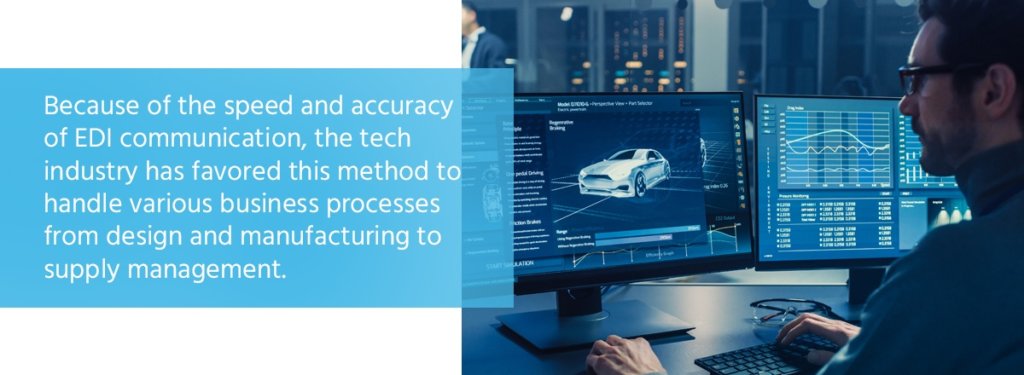

5. Tech Industry
EDI has been a staple in the tech industry for years, allowing for quick communication. Because of the speed and accuracy of EDI communication, the tech industry has favored this method to handle various business processes from design and manufacturing to supply management.
EDI usage isn’t limited to these industries, however. The insurance industry commonly uses EDI to process claims and payments, and educational institutions use it for library material requests, transcripts and loan information. Even the federal government commonly uses EDI for tax filing purposes. As companies expand into a global marketplace, the importance of EDI in eCommerce has only grown.
How EDI Integration Works
The infrastructure for EDI is important to know, but even more essential is understanding how using EDI facilitates electronic transactions step-by-step. The process works as follows:
- The sending facility exports a business document or data set from an in-house application.
- The translation software converts this document or data set from the in-house format to the EDI format.
- EDI processing software checks the EDI document to ensure that it is both structurally accurate and meets EDI standards.
- The EDI document is transmitted to the receiving facility through a direct connection or an EDI network.
- The receiving facility gets the file, and its EDI processing software verifies its validity.
- The receiving facility’s translation software converts the document from the EDI format to the facility’s in-house format.
- The receiving facility’s system processes and integrates the data and sends a notice back to the sending facility to acknowledge the delivery.
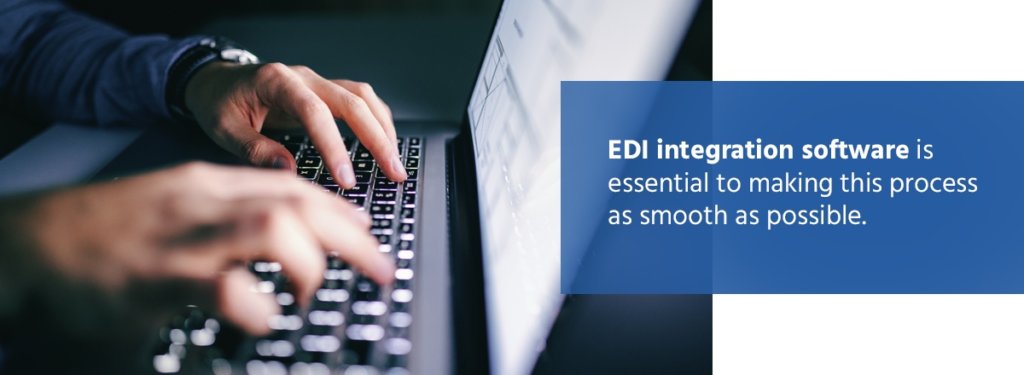

In this system, you can see how each element of EDI infrastructure is used throughout the process. A key point, however, is that EDI integration software is essential to making this process as smooth as possible. When possible, look for software with a wide range of features to choose from, like Final Inventory’s EDI integrations, so that you can effectively customize the solution to fit your needs.
How Can I Add EDI to My Business?
Now that you understand EDI, it’s time to consider how to implement EDI in your business processes. If you’re not already using EDI in your business processes, it may be time to consider using it in your organization. If you are already using EDI, however, it’s important to remember that you can always improve your processes to maximize your use of EDI.
EDI Business Process Review
Whether you’re new to EDI or simply looking for an update, here is a general outline for how to implement or review your current use of EDI in your business processes:


- Review your strategies: Analyze your current business structure and processes and identify areas you could improve with EDI. Consider your organizational structure, your suppliers and the types of transactions your process. If you find an area where EDI can eliminate steps, reduce manual processes or improve inventory or delivery management, add it to the list for further analysis.
- Analyze each possibility: Go through each potential improvement identified in the review stage and evaluate the practicality of implementing EDI. Consider the costs versus the benefits, how long it will take to implement and how implementation may affect other areas of your business.
- Finalize the plan: Once you have identified the best areas to implement EDI, bring a proposal to decision-makers in your business and finalize a plan. Your plan should include any necessary infrastructure improvements.
- Develop your infrastructure: If your business requires any new software or hardware to support your new or improved EDI system, purchase the necessary supplies and install them. Infrastructure development may also include selecting an EDI network provider or other EDI transmission system.
- Integrate EDI: Once you’re ready for EDI, start integrating it into your business. Be sure to run extensive tests and fix any process issues before rolling it out to your business partners.
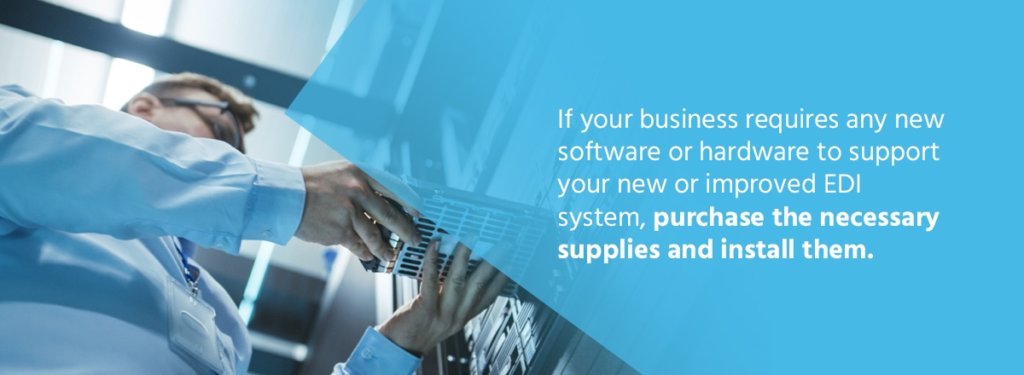

If you’re unsure of how to implement EDI in your business, be sure to work with a specialist in the industry — they can help you identify potential improvements and inform you of how other companies have implemented EDI to their benefit.
Due to the complexity of EDI, smaller companies forgo implementing EDI themselves and partner with companies who has a core competency handling EDI transactions.


Implement EDI With Finale Inventory
EDI is continuing to grow in use across the world. With more resources and options available than ever before, EDI is increasingly viable for businesses of all types and sizes. If you’re looking for a solution that will help streamline transactions, EDI is a great way to go. If you’re ready to give EDI a try, look no further than Finale Inventory.
With Finale Inventory’s SPS Commerce integration, sellers can jump-start large partnerships by automating the exchange of order, shipment, and invoice information with any physical or online retailer. When integrated with Finale, SPS Commerce functions as a sales channel while Finale Inventory functions as a control center for your entire selling operations.
Finale Inventory is a software provider dedicated to providing accurate and innovative inventory management solutions. We understand that no one solution fits all needs, so we create unique solutions customized to the needs of our clients. Starting with small- and medium-sized companies, Finale Inventory now works with businesses of all sizes, including Fortune 500 companies. If you’re looking for an adaptable system with extensive features and comprehensive onboarding, training and support, Finale Inventory has got you covered.
Contact Finale Inventory for more information about our EDI solutions, or start your free trial today and see for yourself what our EDI solutions have to offer.







